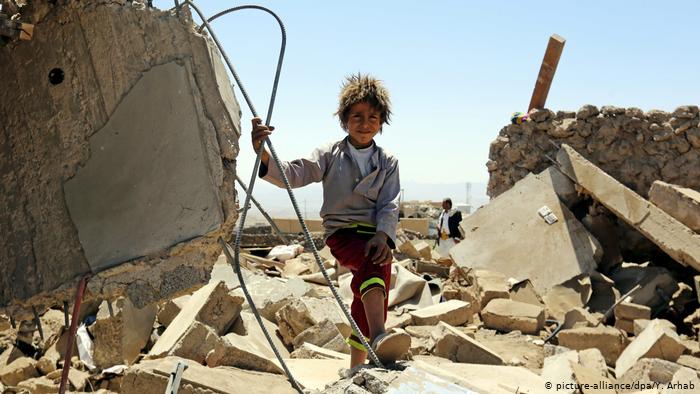Saudi Arabia’s aid and reconstruction initiatives in Yemen aim to secure the kingdom’s influence there in the long term
YemenExtra
SH.A.
By: Jonathan Fenton-Harvey
As Saudi Arabia’s war in Yemen faces increasing condemnation, and as UN-led peace talks ongoing since December appear to be making progress forging a truce between the Houthis and the Saudi-backed government of Abed Rabbo Mansour Hadi, Riyadh may be forced to curtail its military involvement in the country, at least partially. Yet Saudi Arabia is cementing its presence in Yemen through economic and diplomatic initiatives designed to secure its influence even after its military campaign winds down.
Controversial aid donations and reconstruction and development projects across Yemen highlight Riyadh’s long-term ambitions. Such moves would help limit the influence of other external actors such as the United Arab Emirates, which is also jostling for greater influence in southern Yemen, even though Riyadh and Abu Dhabi are working together to fight the Houthis. Likewise, Saudi Arabia’s imposition of tariffs on goods entering Mahra from Oman arguably check the sultanate’s influence in Yemen, particularly its historically strong trading ties with Mahra.
Throughout the conflict, Saudi Arabia’s war strategy has aimed at breaking down Yemen and weakening the state while preventing it from collapsing entirely—which incidentally now provides it more opportunities to lend a “helping hand” in reconstruction. Data compiled by the Yemeni Ministry of Agriculture and Irrigation shows that between March 2015 and August 2016, Saudi Arabia deliberately targeted dams, reservoirs, agriculture, and markets in almost every governorate, particularly near front lines of the conflict in Marib, Sanaa, Taiz, and Aden. From March 2015 until September 2017, 356 Saudi air raids hit farms, 174 targeted marketplaces, and 61 struck food storage sites, according to statistics compiled by the Yemen Data Project, suggesting a deliberate focus on weaponizing access to food and ensuring Yemen’s “total reliance on food imports for survival.” According to the International Rescue Committee, the Saudi-led coalition-funded Yemen Comprehensive Humanitarian Operations (YCHO)—which delivers food, medicine, and commercial aid to Yemenis—is engaging in “war tactics.” By directing aid through Yemen’s key transit and access points, it is helping Riyadh gain control over them rather than addressing Yemen’s immediate humanitarian needs, such as lifting the blockade on Houthi-controlled ports.
Although Yemen relied on imports for 80-90 percent of its food, medicine, and fuel before 2015, trade with Saudi Arabia accounted for only 9.7 percent of these imports. Riyadh is hoping to capitalize on the collapse of Yemen’s infrastructure to increase its share of these imports and keep Yemen dependent on its support. In October, Riyadh agreed to provide Yemen $60 million worth of oil derivatives per month, with the first installment delivered in November 2018 to the eastern and central governorates of Hadhramaut, Shabwa, Al-Jawf, Marib, and Mahra. Skepticism surrounds Saudi efforts to present itself as offering a humanitarian hand to Yemen. In May 2018, it announced long-term plans to focus on developing infrastructure through the Saudi Reconstruction and Development Program in Yemen (SRPY). The program, supervised by Saudi Ambassador to Yemen Mohammad Al Jaber, “includes building and expanding civil, industrial, educational and medical facilities complete with state-of-the art technology [in Yemen],” according to the Saudi Embassy in the United States. While Riyadh conveys this as a benevolent gesture that reflects a desire to help Yemen’s humanitarian crisis, critics note that it mainly enables Saudi Arabia to expand its networks of patronage.
These development and reconstruction projects also provide Riyadh the opportunity reap its own economic benefits, particularly as it seeks to develop new routes to increase its capacity to export oil and gas. According to a letter it sent to Ambassador Al Jaber, the Jeddah-based oil company Huta Marine initiated plans to open an oil exporting port in Mahra in summer 2018. Similarly, Saudi Arabia started constructing an alternative oil pipeline through Mahra to the Arabian Sea in September. Together, the port and pipeline provide a backup export route to the Strait of Hormuz, which Saudi Arabia claims is vulnerable to a potential Iranian blockade.
Such attempts to gain economic influence in Yemen coincide with the kingdom’s strategy to control Yemen’s key logistical hubs, through which it chooses to funnel aid. Bypassing the Houthi-controlled ports of Hodeidah and Saleef does not merely reduce aid to Houthi areas: the sheer volume of aid flowing through coalition-run ports such as Mokha, Mukalla, and Aden also provides incentives for local and international companies to increase these ports’ capacity and make them more efficient. To speed this development process and consolidate Saudi control, Riyadh has built cranes to ensure increased trade activity in and out of the ports. This will increase the economic role of these Saudi-influenced cities in the longer term. In the meantime, as long as Saudi Arabia controls the increased flow of goods through them, the ports themselves are reliant on Riyadh—and more likely to permit or tolerate future economic intervention by Saudi companies.
The views expressed in this article belong to the author.

